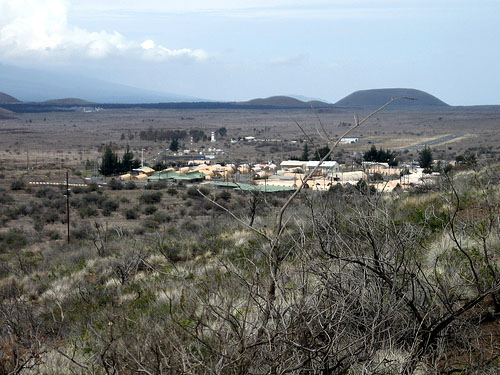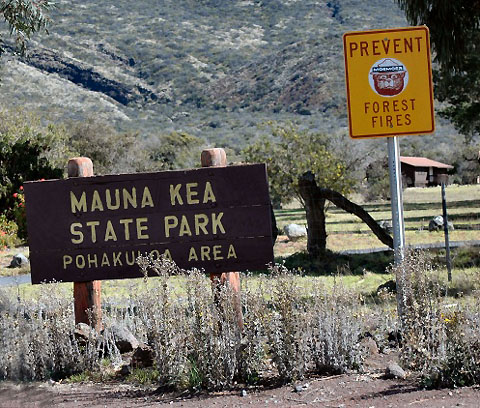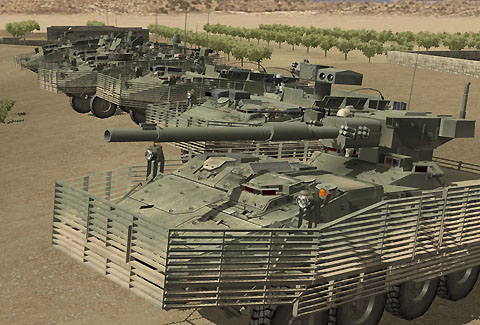www.islandbreath.org ID#0817-05
SUBJECT: MILITARIZATION OF HAWAII
SOURCE: LISA LONG angelsfortruth.com/welcome.html
POSTED: 18 MAY 2008 - 87:30pm HST
More troops may train at Pohakuloa
Army could double live fire training on the Big Island

image above: Base for Army's Pohakuloa range facility. On Flikr.com
|
SUBJECT: MILITARIZATION OF HAWAII
SOURCE: JUAN WILSON juanwilson@mac.com
POSTED: 24 APRIL 2008 - 7:30am HST
Army to keep Stryker brigade in Hawaii

image above: Sign for Mauna Kea State Park belies the nature of its future
by Audrey McAvoy on 16 April 2008 in The Army Times The Army on Tuesday said it has made a final decision to base a Stryker brigade at Schofield Barracks on Oahu and to train the unit at Pohakuloa Training Area on the Big Island, citing strategic advantages provided by the islands. The conclusion comes even though environmentalists have raised concerns about the unit’s 19-ton Stryker vehicles damaging Hawaii’s fragile environment and cultural sites. The service first decided to base the brigade in Hawaii several years ago as part of an Army-wide effort to be ready for rapid deployment to hotspots around the world. In 2005, it started transforming a light infantry brigade at Schofield into a Stryker brigade, a unit of 4,000 soldiers and 310 eight-wheeled Stryker vehicles. But the Army was forced to reconsider its decision in response to a federal appeals court order. The judges said the Army needed to prepare an environmental impact statement that thoroughly analyzed alternatives to basing the force in Hawaii before it reached a conclusion. The Army study, which was completed in February, considered basing the brigade in Alaska or Colorado. On Tuesday, the Army said in a press release Hawaii was selected because the islands allow the military to meet its strategic defense and national security needs. Lt. Gen. Benjamin Mixon, commander of U.S. Army, Pacific, said the decision would send a powerful signal to friends and enemies that the U.S. is committed to its interests in the Asia-Pacific region. “The Stryker brigade’s capabilities significantly increase our ability to win any conflict in the Pacific,” Mixon said. “We know that Hawaii has limited space and beautiful natural resources. We will continue to protect them.” Hawaii’s Democratic U.S. Sens. Daniel Inouye and Daniel Akaka praised the announcement, saying they believed the Army evaluated and weighed environmental and security considerations when making its decision. “We can and must find a balance between preserving Hawaii’s natural and cultural resources, and our need to make sure our brave men and women in the military have the training they need to fulfill their missions,” Akaka said. U.S. Rep. Neil Abercrombie, D-Hawaii, said he “looked forward to reading the decision in detail and understanding the Army’s rationale.” David Henkin, an Earthjustice lawyer who represented environmentalists and Native Hawaiian groups in the court case, said a preliminary review of the Army’s decision provided some welcome news. He pointed to the part where the Army said it would consider building a live-fire training range alternative to Makua Military Reservation, which is located in a valley Native Hawaiians consider sacred. Henkin’s clients had been concerned that the Stryker brigade would occupy space that could be used for live-fire training instead of Makua Military Reservation. The Army’s official Record of Decision addressed that concern, Henkin said. “It’s a very positive development because it indicates that finally there is an openness to at least evaluating alternative locations to Makua,” Henkin said. The Army considers Makua vital to soldier readiness but Native Hawaiian groups value the remote valley for its temples and other sacred and cultural sites. Environmentalists point to several dozen endangered species that inhabit the valley. Henkin said he was still reviewing the rest of the document to see whether it provides enough information for the reasons behind Hawaii’s selection. The brigade will also train at Oahu locations, including Schofield Barracks, Dillingham Military Reservation, Kahuku Training Area, Kawailoa Training Area and Wheeler Army Airfield. |
SUBJECT: MILITARIZATION OF HAWAII
SOURCE: LANNY SINKIN lanny.sinkin@gmail.com
POSTED: 17 FEBRUARY 2008 - 10:00am HST
Army EIS picks Hawaii as Stryker 1st choice

image above: Combat Mission Shock Force featuring7 Stryker models most relevant on the battlefield.
Computer generated simulations of Strykers from www.BattleFront.com game simulation.
[Lanny Sinkin comments: Strengthening the forward base for the war with China.] |
see also:
Island Breath: Ban recruiting aimed at minors 2/11/08
Island Breath: Military Mining for Kids 1/19/06
Island Breath: DU found at Pohakuloa Range 8/21/07
Island Breath: Navy Expansion Plan for PMRF 8/7/07
Island Breath: Militarism in Hawaii 5/ 17/07